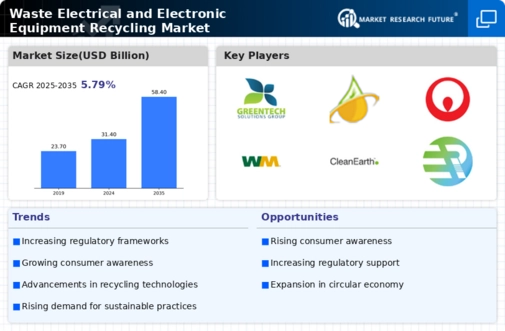Increased E-Waste Generation
The rapid advancement of technology and the proliferation of electronic devices have led to an unprecedented increase in e-waste generation. The Waste Electrical and Electronic Equipment Recycling Market is directly impacted by this trend, as more electronic products reach the end of their lifecycle. Estimates suggest that the volume of e-waste is expected to reach 74 million metric tons by 2030, creating a pressing need for effective recycling solutions. This surge in e-waste presents both challenges and opportunities for the recycling industry. Companies that can efficiently process and recycle these materials stand to benefit significantly. The growing volume of e-waste is likely to drive investments in recycling infrastructure, thereby fostering growth within the Waste Electrical and Electronic Equipment Recycling Market.
Rising Environmental Concerns
Growing environmental awareness among consumers and businesses is significantly influencing the Waste Electrical and Electronic Equipment Recycling Market. As the detrimental effects of electronic waste on the environment become more apparent, there is an increasing demand for sustainable recycling solutions. Consumers are now more inclined to support companies that prioritize eco-friendly practices, including responsible e-waste disposal. This shift in consumer behavior is prompting businesses to adopt sustainable practices, thereby enhancing their brand image. Market data indicates that companies with robust recycling programs are likely to experience higher customer loyalty and retention rates. Consequently, the Waste Electrical and Electronic Equipment Recycling Market is poised for growth as stakeholders recognize the importance of environmental stewardship.
Stringent Regulatory Policies
Regulatory frameworks play a crucial role in shaping the Waste Electrical and Electronic Equipment Recycling Market. Governments are increasingly implementing stringent regulations aimed at managing electronic waste effectively. These policies often mandate proper disposal and recycling of electronic products, thereby creating a structured environment for recycling operations. For example, the introduction of extended producer responsibility (EPR) laws compels manufacturers to take responsibility for the entire lifecycle of their products, including end-of-life disposal. This regulatory push is expected to drive the market, as compliance becomes essential for manufacturers and recyclers alike. The Waste Electrical and Electronic Equipment Recycling Market is likely to see a rise in demand for compliant recycling services, fostering growth and innovation.
Consumer Demand for Responsible Disposal
There is a notable shift in consumer attitudes towards the disposal of electronic products, which is positively influencing the Waste Electrical and Electronic Equipment Recycling Market. As consumers become more educated about the environmental impacts of improper e-waste disposal, they are increasingly seeking responsible recycling options. This demand is prompting retailers and manufacturers to offer take-back programs and recycling initiatives, thereby facilitating the proper disposal of electronic devices. Market trends indicate that companies that actively promote responsible disposal practices are likely to enhance their market share. The growing consumer expectation for accountability in e-waste management is expected to drive the Waste Electrical and Electronic Equipment Recycling Market forward, as stakeholders adapt to meet these evolving demands.
Technological Innovations in Recycling Equipment
The Waste Electrical and Electronic Equipment Recycling Market is experiencing a surge in technological innovations that enhance recycling processes. Advanced machinery and automated systems are being developed to improve the efficiency of material recovery from electronic waste. For instance, innovations such as artificial intelligence and machine learning are being integrated into sorting systems, allowing for more precise separation of recyclable materials. This not only increases the recovery rates but also reduces operational costs. As a result, the market is projected to grow significantly, with estimates suggesting a compound annual growth rate of over 10% in the coming years. The adoption of these technologies is likely to attract investments, further propelling the Waste Electrical and Electronic Equipment Recycling Market.


















Leave a Comment